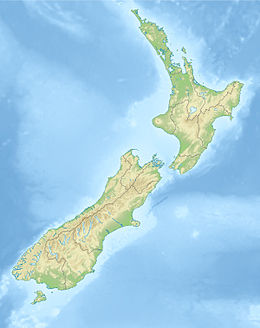1987 Edgecumbe earthquake
 |
|
| Date | 2 March 1987 |
|---|---|
| Origin time | 1:42 pm NZDT (UTC+13) |
| Magnitude | 6.5 Mw |
| Depth | 8 kilometres (5 mi) |
| Epicenter | 37°53′S 176°50′E / 37.88°S 176.84°ECoordinates: 37°53′S 176°50′E / 37.88°S 176.84°E |
| Areas affected | New Zealand |
| Tsunami | None |
| Casualties | 25 injured |
The 1987 Edgecumbe earthquake measured 6.5 on the moment magnitude scale and struck the Bay of Plenty region of New Zealand at 1:42 pm on 2 March. The hypocentre was at a shallow depth of 8 km. The epicentre was 2.24 kilometres (1.39 mi) south-south-east of the town of Matata, and 15 kilometres (9.3 mi) north-north-west of Edgecumbe, on the Rangitaiki Plains (the floodplain of the Rangitaiki River, the Tarawera River and the Whakatane River). It was the most damaging earthquake New Zealand had experienced since the 1968 Inangahua earthquake.
The main shock was preceded for two weeks by earthquake swarms in two areas of the Bay of Plenty. A swarm started on 21 February off-shore from Maketu, near Te Puke, 40 kilometres from the main shock's epicentre, and another swarm started on 26 February between Matata and Thornton, very close to the epicentre. Then there was a 5.2 ML (Richter magnitude) earthquake at 1:35 pm on 2 March, followed by the main shock seven minutes later. The main shock appears to have actually consisted of two ruptures, and possibly a third. There were indications that the first rupture propagated towards the south-west, triggering a second rupture 9 kilometres to the south-west and three seconds after the first. There is also the possibility of a third, signicantly smaller, rupture another ten seconds later. The largest aftershock measured 5.6 and struck nine minutes later at 1.51 pm.
Eleven ground-surface ruptures occurred in the Rangitaiki Plains, though no active faults had previously been recognised on the Plains. The largest rupture, the Edgecumbe Fault, was 7 kilometres (4.3 mi) long and formed on, and extended, a late Holocene fault scarp. The old scarp had previously been unrecognised, but was later seen in aerial photographs taken before the earthquake. The northern end of the scarp is one kilometre east of Edgecumbe, and the scarp runs southwest to a point three kilometres north of Te Teko. The land on the north-western side dropped by up to 2.1 metres (6.9 ft), and that area is now more prone to flooding. The most spectacular feature of the scarp was a deep prominent fissure up to 3 metres wide and 3–4 metres deep, mostly with near-vertical walls, that opened up along the fault. It appears that the fault has ruptured at least once previously in the past 1800 years. The intense ground shaking led to a large number of ground surface failures, including sand boils, ridge-top shatters and debris avalanches on steeper slopes.
...
Wikipedia


